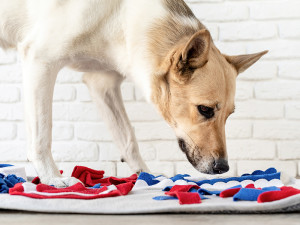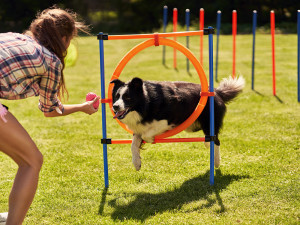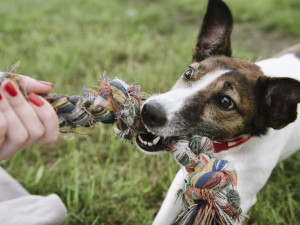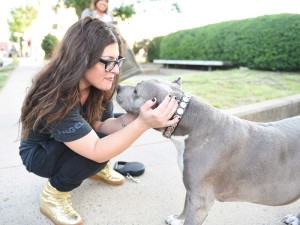Meet The Makers: Denny Hamill of iFetch
From idea to product—how this successful start-up got the ball rolling
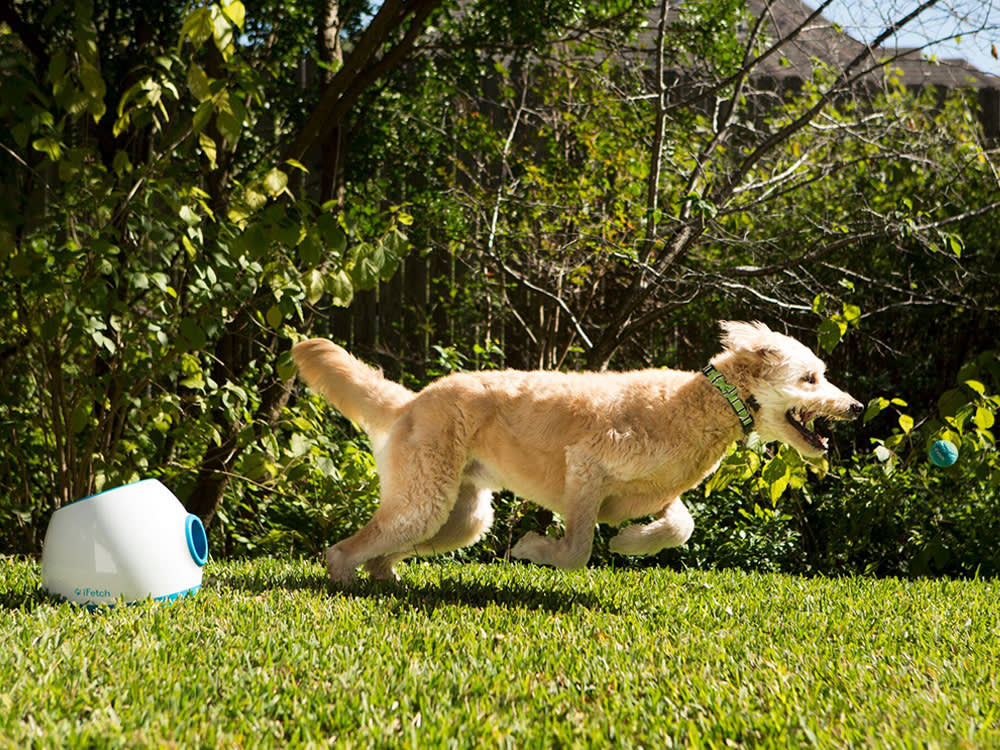
share article

Your pet wants you to read our newsletter. (Then give them a treat.)
Denny Hamill is the owner, CEO and co-inventor of iFetch, makers of automatic ball launchers that provide dogs the ability to play fetch to their heart’s content. The award-winning, family-owned company launched the iFetch from a highly successful Kickstarter program in 2013 and quickly gained media attention, sales and a host of fans. Their family of products now includes iFetch Too (for large dogs), iFetch Frenzy (featuring a more interactive design) and iDig (an interactive digging toy). Denny’s grandson, Grant Hamill, is credited as co-inventor of the product, who along with the family dog Prancer, helped inspire the iFetchopens in a new tab concept.
How did you come up with the idea for iFetch?
We came up with the idea for iFetch when our miniature poodle, Prancer, wouldn’t let Grant do his homework because he insisted Grant play fetch with him. Prancer would drop the ball in his lap and then bark until Grant threw it. An exasperated Grant looked at me and asked, “Can we make a machine that will automatically throw the ball so I can get my homework done?” And the idea for iFetch was born.
Wow, what a chain reaction this question set in motion. At this point in my career, I was approaching retirement after a 25+ year career as an executive at 3M. I also held a PhD in Physics, which certainly helped jump start the design process for a complex idea like this one. Add to the mix my very clever grandson, Grant, who loved understanding “how things work,” and we were a pretty formidable team. It really was that perfect union of the right idea at the right time.
What were the main design-mechanical challenges?
There were many design challenges. We developed early prototypes using HotWheels® tracks and other miscellaneous items as we tinkered. We then decided it was time to engage with a local industrial design firm to develop design options for the launcher, and then we chose the final concept.
We also engaged with another product engineering firm in Austin to finalize the mechanical and electrical design, components and assembly in order to move to the manufacturing phase. Throughout the process, we created and filed patents and trademarks. It was truly a labor of love, and we had great partners along the way.
What were some of the surprise problems or glitches that popped up along the way?
Out of the gate, we really didn’t have many glitches. Given my work experience, I knew how important it was to go through the proper product commercialization phases: Concept, Feasibility, Development and Scale-up, and we made pretty good choices. The downside is that it took much longer than we had anticipated. (So many details!)
Once we started shipping products and receiving more customer feedback, we did discover a couple of surprise issues we had missed during the initial testing phase—slobber and sunlight. Prancer and our other dutiful testers didn’t slobber much, so we didn’t experience slobber causing the wheels that launched the ball to slip.
We did come up with a temporary solution of having high slobber dogs use squash balls with the iFetch, which seemed to help. We’ve recently discovered a solution—a slobber proof ball for the iFetch Too. It’s a mix of foam and rubber that will launch consistently no matter the level of slobber. Since we did most of our testing inside, we also didn’t know that sunlight could interfere with our optical switch until a customer in Florida wrote to us, so we’ve had to make some component changes along the way as well. Launching a product is not for the faint of heart!
Please describe your product line—iFetch, iFetch Too and the iFetch Frenzy.
After the iFetch automatic ball launcher reached the market in 2014, we had many customer requests for a launcher for bigger dogs. The original iFetch used a mini tennis ball best for small to medium breeds. So, we set off making the iFetch Too—to launch a standard sized tennis ball, which started shipping in 2015. We designed both of the launchers to only launch one ball at a time because we wanted the toys to be interactive. There are long-lasting benefits of engaging a dog’s mind as well as his body, which has always been an important component of our product development strategy. We want our toys to provide both mental and physical stimulation in order to keep dogs healthy and happy. As we were manufacturing the iFetch Too, we came up with a great idea for a new twist on the game of fetch, and quickly developed the iFetch Frenzy, a non-electronic brain game that uses a mini tennis ball, which launched in 2016. After a whirlwind of product launches over the course of a few years, we decided to take a break from product development for a little while.
I see that you funded your initial product via Kickstarter with resounding success, and then later funded your iFetch Too for larger dogs with another Kickstarter campaign. Can you talk about your experience crowdfunding for a product launch and, perhaps, the benefits?
In 2013, we heard about Kickstarter, a new crowdfunding platform. We thought it would be a good way for us to raise a little seed capital by getting sponsors to “pre-pay” for early product shipments, but, more importantly, it would also give us an idea of the market demand for a new product like this. We set an initial goal of $20,000 with a time period of 30 days. The response was humbling. We ended up raising around $90,000 and had over 1,200 backers! That was the encouragement we needed to continue our investment of time and money to bring the iFetch to market.
We also turned to Kickstarter a year later to raise money (and interest) for the iFetch Too ball launcher. And, again, we received enthusiastic support from the Kickstarter community. We had just under 1,000 backers and raised over $100,000 in 30 days. Kickstarter confirmed that there was a market for our dog toys, and six years later our family is still in business and going strong. Kickstarter allows you to market your idea to a community of early adopters, giving you an initial reaction of how your product will be received by the greater consumer community. There is definitely pressure to fulfill the product shipments to these early backers, which was pretty stressful for us as we experienced some manufacturing delays early on. However, in the end, it was a great “gut check” for us before we spent more time and money on the idea.
Are there unexpected applications of the iFetch? Perhaps in training?
Yes! The iFetch is a great training aid for puppies and adult dogs. It makes us sad when we see press about how iFetch toys are for the “lazy dog owner.” This couldn’t be farther from the truth! You have to work with your dog to train them to drop the ball into the top of the ball launchers or Frenzy to initiate the action. Sure, many pet parents end up being the “dropper” (kids especially love this role), but that’s ok. Playing with the iFetch presents many opportunities for training.
Even if the dog hasn’t mastered the “drop,” they need to learn to stand and wait a proper distance away from the chute to avoid being hit by the launching ball. They also need to learn to retrieve and bring the ball back. All of these actions require the dog to use their mental capacity, which is so important for their health.

Cameron Woo
Cameron Woo was co-founder, publisher, and art director of The Bark magazine.
Related articles
![Border collie dog and a woman on an agility field]() opens in a new tab
opens in a new tabA Crash Course on Dog Agility Training
5 reasons to get your dog in the agility game, from burning energy to building confidence.
![A dog tugging on a toy outside]() opens in a new tab
opens in a new tabThe Definitive Guide to Choosing Safe Dog Toys
Tips for pet parents who want their pups to have safe fun.
![Bullmastiff puppy chewing on a purple ring chew toy]() opens in a new tab
opens in a new tab11 Tough Toys for Power Chewers
Veterinary behaviorist Dr. Valli Parthasarathy reccos the most durable dog toys for destructive players.
![Rebecca Corry with her dog]() opens in a new tab
opens in a new tabComedian Rebecca Corry Stands Up for Pit Bulls
“Comedy and entertainment — that’s my passion. But my purpose in life is saving dogs. And somehow I have managed to combine the two.”
